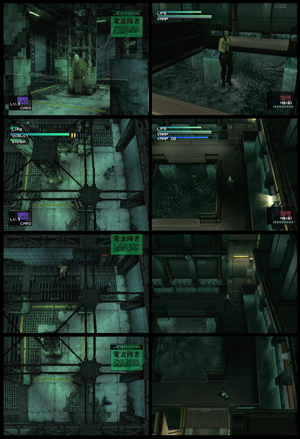Vamp represented a more complex formal mixture. He initially recalled MGS1’s Decoy Octopus whom Snake had accidentally killed during a
cutscene. Raiden accidentally killed Vamp during a cutscene that followed the Fortune fight, yet he quite visibly put a bullet into Vamp’s brain.
Snake had learned afterwards that Octopus had died, while Raiden later learned
that Vamp had survived.

|
The formally similar level designs worked in opposite ways. Snake died from an explosion if the player had triggered the plastic explosives in MGS1, whereas Raiden died from crushing pressure if he fell into the pool. The actors left through opposite doors after each fight. Snake couldn’t leave through the northeast door because he lacked the right cardkey in MGS1, and Raiden could only exit northeast to progress forward.
The gameplay formally resembled Snake’s MGS1 fight against Ocelot. Ocelot could shoot Snake from any position in the room. MGS1 had forced the player to move constantly until Ocelot reloaded. The player could use that chance to attack Ocelot through the explosive’s wires. Vamp likewise threw knives at Raiden from any position in the room, and MGS2 forced the player to run constantly around the square arena unless Vamp was swimming. The player could use that chance to attack Vamp through the pool’s surface.
The gameplay also formally resembled Snake’s MGS1 fight against Psycho Mantis. The player couldn’t shoot Vamp just as he hadn’t been able to shoot Mantis, and the secret to success laid in the player’s controls. The player had to switch his controller’s port to defeat Mantis in MGS1, and Vamp dodged all bullets unless the player took his finger off the controller’s L1 button while looking in first-person view. Both fights forced the player to change the way he literally operated the game console’s technology in order to complete his Player Objectives.
Raiden’s second fight against Vamp formally echoed Snake’s second fight against Sniper Wolf in MGS1. Both fights required the player to use his sniper rifle across a large, open area, but the strategies were reversed. In MGS1, the player had to run laterally across the level to find Wolf’s hiding spot, and Wolf ran laterally from tree to tree. However, neither Vamp nor Raiden moved. The player had wanted Wolf to reveal herself in MGS1, while Vamp stood in full view behind his hostage in MGS2.
Vamp survived all his injuries, and many players still cite “bisexual vampire” as one of MGS2’s worst plot elements. However, on the terms of this analysis, MGS2’s narrative arose from its form. The dismissal is fallacious since it regards Vamp’s immortality as a narrative rather than a formal element.

|
MGS2 most heavily corrupted Vamp’s slice of the Scenario Map when it denied the catharsis that MGS1 had given when Liquid suffered a deus ex machina death. Liquid had died because MGS1 had wanted him dead. Vamp reappeared in the background during MGS2’s final cutscenes because the game deliberately wanted to kill the dramatic tension that MGS1 had established through Liquid’s death after multiple surprise returns.
MGS2 finally inverted the Scenario Map when Raiden failed to prevent a terrorist attack from the newest doomsday
machine, Arsenal Gear—a large digitized battleship that Raiden rode into New York Harbor
and beyond. The hull crashed into New York City, nearly destroying Federal Hall. The game
had originally called for Arsenal Gear to upset the Statue of Liberty, though Kojima Productions removed the scene out of respect for New York City’s then-recent losses. In the most dramatic and topical way possible, the player’s success guaranteed the actor’s and the Scenario Map’s failures.
<< VII: Fatman and Fortune IX: The Solid Map >>